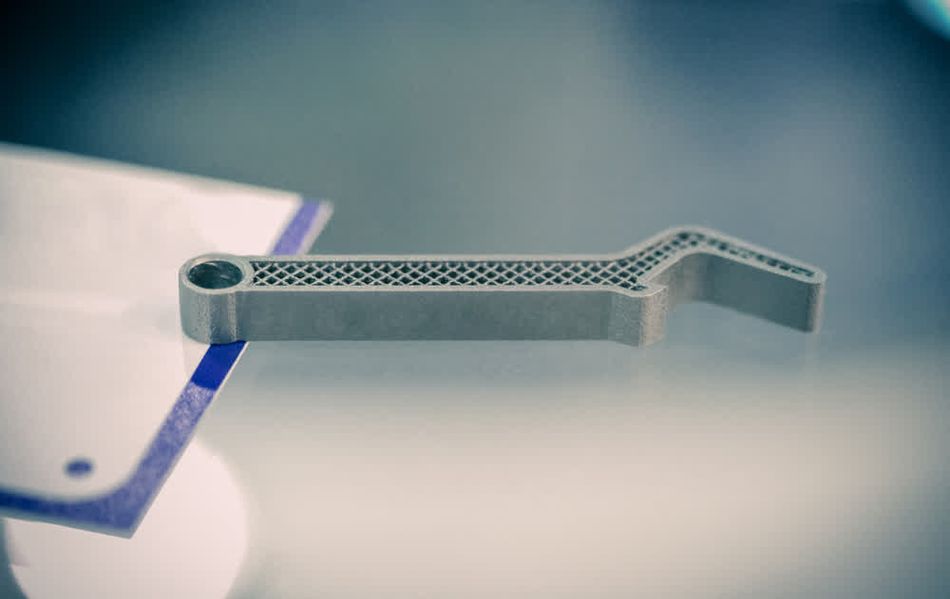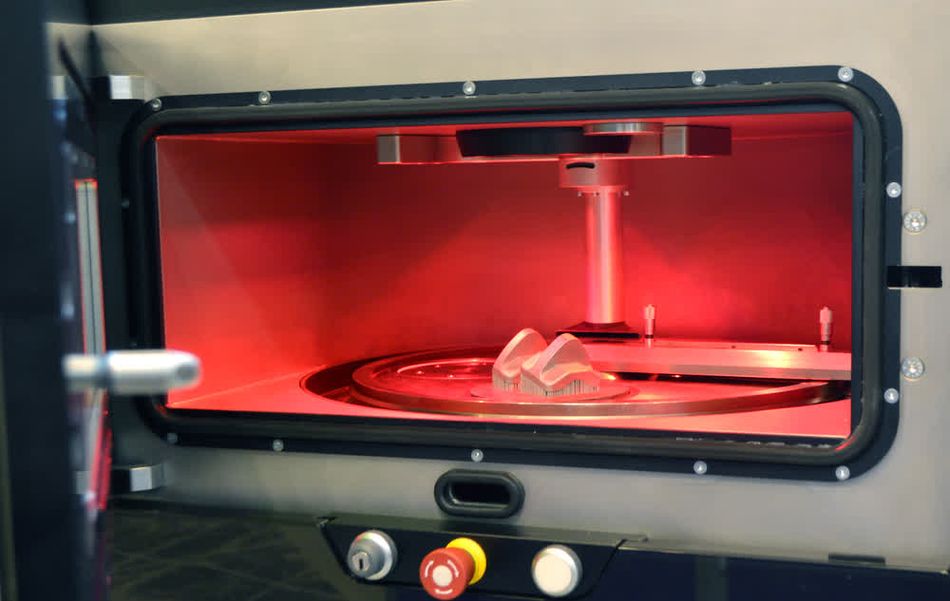3D Printing Titanium: Best Processes, Alloys, Applications
In metal additive manufacturing, titanium powders have some of the most high-value applications, from aerospace manufacturing to patient-specific medical implants.
Titanium, known for its formidable strength and lightweight properties, is one of the most important materials in metal 3D printing. When formulated as an additive manufacturing powder, titanium offers a broad range of capabilities within fields such as aerospace, medical, and automotive.
3D printing titanium allows for the creation of complex, bespoke parts that leverage the desirable material properties of titanium — biocompatibility, high strength, and beyond — in previously unworkable geometries. The use of titanium with advanced metal 3D printing technologies like direct metal laser sintering can propel industries toward more innovative, efficient, and sustainable practices.
This article looks at the basics of 3D printing titanium, discussing key additive manufacturing technologies, printable titanium alloys, and common applications.
Why Titanium 3D Printing Offers Huge Potential
Titanium has turned metal 3D printing into a high-value opportunity for manufacturers. Known for its superb strength-to-weight ratio, titanium is a cornerstone in sectors such as aerospace and automotive engineering, enabling the creation of components that are not only lighter and stronger but also more durable.[1]
Biocompatibility is another standout feature of titanium, making it a preferred material in medical applications.[2] It is used extensively for implants and prosthetic devices that need to interact harmoniously with the human body while offering longevity and resistance to wear in a biological environment. This compatibility is essential for patient safety and the reliability of medical devices.
Furthermore, titanium's inherent high corrosion resistance ensures that products last longer even under harsh conditions, such as during exposure to saltwater or corrosive chemicals.[3] This makes it invaluable in industries like marine engineering and chemical processing where material longevity is as crucial as its strength.
On a technical level, titanium's mechanical properties include high fatigue resistance and excellent fracture toughness, allowing it to withstand rigorous operational demands. Its thermal stability also stands out, maintaining structural integrity across a wide range of temperatures, which is pivotal in high-temperature applications in aerospace and automotive manufacturing.
Recommended reading: Metal manufacturing processes compared: machining, forging, casting, powder, additive, extrusion
Titanium 3D Printing Processes

Titanium 3D printing technology is dominated by two main technologies: direct metal laser sintering (DMLS) — otherwise known as laser powder bed fusion (L-PBF) or Selective Laser Melting (SLM) — and electron beam melting (EBM). The former is more widespread than the latter, with a greater number of 3D printer manufacturers.
Other titanium 3D printing technologies include binder jetting, in which titanium is deposited along with an adhesive binder that is then burned away during post-processing, and direct energy deposition (DED).
Titanium DMLS
DMLS uses a precise, high-power laser to fuse titanium powder into a solid structure. The process begins with a layer of titanium powder spread over the build area. A laser beam then selectively melts the powder by tracing the predefined path of the object’s cross-section, fusing the titanium particles together and to the layer below. This method allows for the creation of highly complex geometries, which are otherwise difficult to achieve with traditional manufacturing techniques. The primary challenge in DMLS is managing the high melting point of titanium alloys, which requires a very powerful laser and careful control of the energy input to avoid defects like warping or residual stresses.
Manufacturers of laser-based systems for titanium 3D printing include EOS, Colibrium Additive (formerly GE Additive), and Nikon SLM Solutions (formerly SLM Solutions).
Titanium EBM
EBM, on the other hand, utilizes a high-energy electron beam under vacuum to melt the titanium powder. This beam scans across a bed of titanium powder, melting and solidifying the material layer by layer according to the digital design. EBM is particularly effective at managing the reactive nature of titanium because the vacuum environment prevents oxidation, which is a common issue when titanium is heated in an air atmosphere. The electron beam can also be adjusted dynamically in terms of focus and power, allowing for precise control over the melting process, which is crucial for maintaining material properties and structural integrity.
Manufacturers of EBM systems for 3D printing titanium include Colibrium Additive (formerly GE Additive) and Mitsubishi subsidiary TADA Electric.
Industries Using Titanium 3D Printing
Titanium 3D printing has been a game-changer in several sectors, driving innovation and efficiency with its unique properties. While virtually all industrial sectors can use titanium 3D printing, three of the most important are aerospace, automotive, and medical.
Aerospace
In the aerospace and aviation industry, titanium’s strength-to-weight ratio enables the production of complex components that are both lighter and more durable than those made with traditional materials. For instance, leading aerospace manufacturers use titanium 3D printing — often powder bed fusion process — to create parts for jet engines and airframes, resulting in aircraft that are not only more fuel-efficient but also capable of withstanding the extreme stresses of flight.[4]
Automotive
In the automotive sector, the ability to print metal parts with titanium has led to the development of customized, high-performance vehicle parts. Manufacturers can produce lightweight yet robust printed parts like gears and brackets, which contribute to overall vehicle weight reduction and enhanced performance. This application is crucial in the context of electric vehicles, where efficiency and battery range are significantly improved by reducing the vehicle's weight.
Medical
The medical industry benefits particularly from the biocompatibility of titanium. 3D printing with titanium allows for the production of tailored implants and prosthetics that fit patients with unprecedented precision. These corrosion-resistant, biocompatible implants are not only stronger and more durable but also integrate better with human tissue, which improves the recovery process and overall outcomes for patients. Titanium surgical instruments and machine components can also be printed.
Titanium Alloys for 3D Printing
Titanium is a mainstay of metal additive manufacturing because, despite its hugely desirable material properties, it is not especially difficult to print. In fact, it is much better suited to 3D printing than other processes like CNC machining.
Material manufacturers make titanium powders tailored for 3D printing. These metal powders are engineered for uniform particle size and shape, improving flowability and packing density in the print bed. This enhancement leads to smoother, more detailed prints and strengthens the mechanical properties by reducing inclusions and porosity.
Most titanium 3D printing applications use titanium alloys — metal materials containing titanium alloyed with other elements — instead of pure titanium. The type of titanium alloy used depends on the specific 3D printing application. Some common varieties are shown in the table below.
Alloy | Grade | Description | Applications |
Ti-6Al-4V | 5 | The most common and important titanium alloy for 3D printing, with excellent strength-to-weight, corrosion resistance, and biocompatibility | Aerospace components, automotive components, surgical instruments, medical implants |
Ti-6Al-4V-ELI | 23 | This purer titanium alloy has an “extra-low interstitial,” making it slightly weaker than Grade 5 but better for biomedical applications | Surgical instruments, medical implants |
Ti-6Al-2Sn-4Zr-2Mo | A near-alpha titanium alloy with high strength and excellent corrosion resistance | Aerospace components, aviation components, marine components | |
Ti-5Al-5V-5Mo-3Cr | A beta titanium alloy with high strength and toughness that shows promise in 3D printing due to its poor machinability | Industrial components |
Technical Challenges

Titanium 3D printing, highly valued for its exceptional properties like high strength and lightweight, confronts several engineering challenges. One such challenge is the stringent requirement for temperature control. Titanium’s high melting point necessitates precise thermal management during the printing process. Inconsistent temperature can lead to material stress and deformation, which are detrimental in applications requiring high precision such as aerospace components and surgical implants.
Ensuring material sintering uniformity is another critical technical hurdle. The quality of titanium prints heavily depends on the uniformity of the sintering process. Variations can introduce weak points that compromise the structural integrity, making the parts unsuitable for high-stress applications. This challenge is particularly pronounced in the production of complex geometries where even minor faults can lead to catastrophic failures.
The need for specialized support structures is also a notable challenge. These supports are essential to combat gravity and thermal distortion during printing but removing them without damaging the intricate parts requires meticulous techniques. The precision necessary in this step is crucial for industries like automotive and biomedical, where even minute imperfections can render a part unusable.
The Cost of 3D Printing Titanium
Titanium 3D printer costs: $250,000–$1,000,000
Titanium powder costs: $300–$600 per kilogram
Titanium parts from service provider: Approx. 2–3x raw material cost
Titanium 3D printing is transformative in high-stakes industries like aerospace and healthcare but comes with substantial initial costs. Industrial-grade DMLS systems, for example, can cost six or seven figures. The production of titanium powder, essential for 3D printing, is costly due to the need for high purity and fine particle consistency, processes that are both energy-intensive and technologically demanding. These costs are further compounded by the environmental impact of titanium extraction and processing, which often involves extensive safety and regulatory compliance.
Despite the high initial investment, sectors that demand exceptional material properties find significant long-term value. Aerospace applications, for example, benefit from reduced aircraft weight leading to lower fuel costs and increased range, while medical implants from titanium offer longevity that decreases the need for repeat surgeries, dramatically improving patient care and reducing healthcare costs. Alternatively, using a 3D printing service for one-off parts and prototypes is more feasible and cost-effective for smaller companies, though lead times will naturally be longer than in-houe printing.
Operational savings are palpable when considering the longevity and reduced maintenance needs of titanium parts. These benefits, combined with ongoing advancements in 3D printing technology that promise to lower production costs, enhance the economic case for titanium in these critical fields. As efficiencies in titanium powder production improve, we can expect broader adoption in other industries, leveraging titanium’s unique properties more economically.
Recommended reading: An Advanced Guide to Metal Injection Molding
Conclusion
Titanium 3D printing stands at the forefront of technological innovation, enhancing industries from aerospace to medicine. The suitability of titanium for powder-based additive processes, coupled with the inherently desirable properties of certain titanium alloys, makes titanium 3D printing a valuable proposition for many sectors. As the technology evolves, ongoing advancements in material science and engineering are expected to lower costs and expand applications, making titanium 3D printing even more accessible and impactful.
Frequently Asked Questions
What makes titanium ideal for 3D printing in aerospace applications?
Titanium's high strength-to-weight ratio allows for the production of lightweight, durable components that reduce overall aircraft weight and enhance fuel efficiency.
How does titanium's biocompatibility benefit medical 3D printing?
Titanium is non-toxic and not rejected by the body, making it perfect for medical implants that require long-term interaction with human tissue.
What are the main challenges in 3D printing with titanium?
Key challenges include managing the high melting point of titanium, ensuring uniform material sintering, and the costs associated with specialized printing equipment.
Can titanium 3D printing be used for mass production?
While currently more suited to bespoke designs and prototypes due to cost and complexity, ongoing advancements are likely to enable more widespread use in mass production.
References
[1] Boyer RR. Titanium for aerospace: rationale and applications. Advanced Performance Materials. 1995 Oct;2:349-68.
[2] Baltatu MS, Tugui CA, Perju MC, Benchea M, Spataru MC, Sandu AV, Vizureanu P. Biocompatible titanium alloys used in medical applications. Rev. Chim. 2019 May 15;70(4):1302-6.
[3] Mountford Jr JA. Titanium-properties, advantages and applications solving the corrosion problems in marine service. InNACE CORROSION 2002 Apr 7 (pp. NACE-02170). NACE.
[4] Śliwa RE, Bernaczek J, Budzik G. The application of direct metal laser sintering (DMLS) of titanium alloy powder in fabricating components of aircraft structures. Key Engineering Materials. 2016 May 21;687:199-205.
Table of Contents
Why Titanium 3D Printing Offers Huge PotentialTitanium 3D Printing ProcessesTitanium DMLSTitanium EBMIndustries Using Titanium 3D PrintingAerospaceAutomotiveMedicalTitanium Alloys for 3D PrintingTechnical ChallengesThe Cost of 3D Printing TitaniumConclusionFrequently Asked QuestionsReferences
